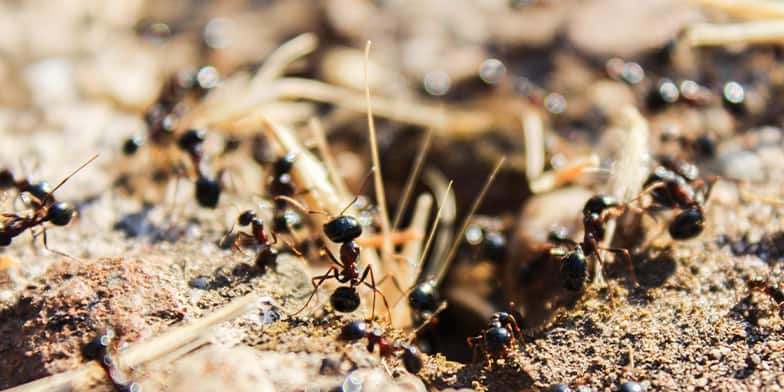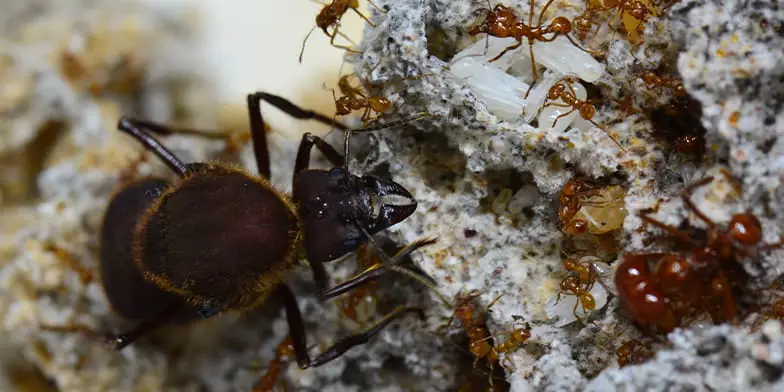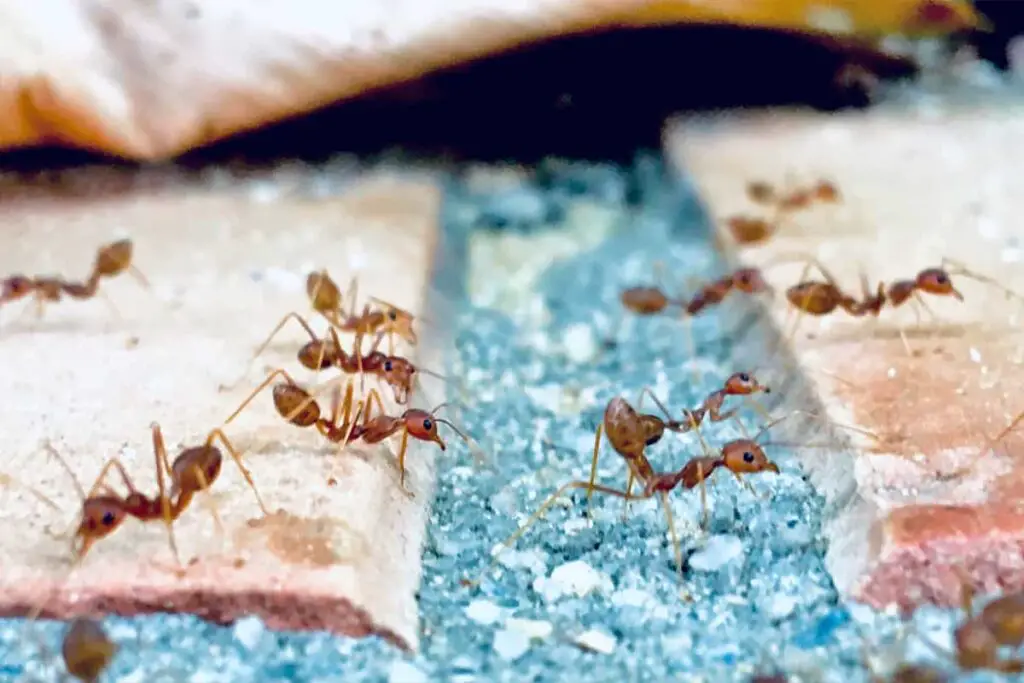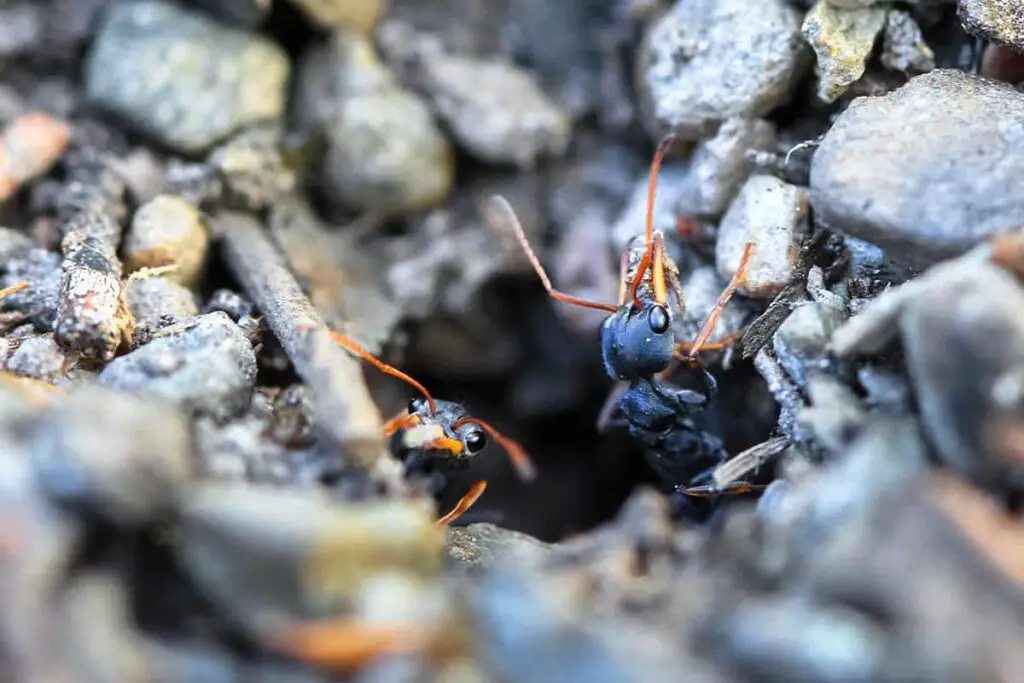
Enjoying your walk on a sunny day at the park, you look down and become mesmerized by the colony of ants. Hundreds of them walk past your shoes and you wonder, “Have I ever seen the queen?”
The queen ant stays inside the nest at all times, protected by her workers. She may only leave the nest if it is under threat and therefore needs to establish a new home. This might happen due to human intervention, attacks from predators or natural causes.
If you do happen to see a colony of ants leaving their destroyed nest, what are the chances of you spotting the queen? Well, there are a few things that you can be on the lookout for.
Why Would a Queen Ant Come Out?
It is extremely rare for anyone to encounter a queen. The lucky chances when someone had seen one, it was most likely due to a very unfortunate circumstance where the nest has been destroyed.
The nest can be destroyed by humans who want to prevent infestation or simply because of heavy rain, especially during the warm spring and summer months. When the nest is destroyed, the queen ant immediately needs to leave the nest to establish a new home. And to do so, she might fly to mate with other male ants from another nest. Yes, the queen does have wings. But unfortunately, she will lose them after mating.
The queen also doesn’t typically come out to forage for food neither. The ant workers will retrieve food for her. Additionally, she also uses proteins in the decaying muscles of her wings as a food reserve.
Why Is a Queen Ant Important?
A queen ant is important as her main role is to populate and sustain the colony. She is responsible for giving birth to the ants in her settlement. Thus, this role finds her to be the most protected within the colony.
The queen reproduces by storing sperm in a pouch in her abdomen. She uses the sperm to fertilize her eggs. The fertilized eggs will develop as females and the well-nurtured ones will potentially become young queens themselves. The unfertilized eggs on the other hand will develop as males. Once the colony is established with ant workers, she will lay eggs continuously.
However, new queens will have to leave to mate and build a colony of their own. This is where their wings come in handy as during this ‘nuptial flight’ is when ants mate. This happens periodically, often 3-5 days after a rainstorm when the winged ants (both the males and the young queens) will emerge from the colony and mate. After this mating process, the male dies and the queen will eventually shed her wings.
Sometimes, a colony can contain more than one queen although the ant workers will kill off the others so there can be only one that populates and sustains the colony.
How To Spot A Queen Ant
A queen ant is often the largest amongst the other members of the colony. The queen has a thicker body; she has an enlarged thorax (or abdomen) that is very noticeable.
You can also note how much attention the other ants are paying to her as they are usually all over the queen, feeding and cleaning her. The other ants will also help in protecting her eggs.

Where To Find an Ant’s Nest
Regardless of the type of ants that you are looking for, you can be sure to find ants to be nesting in either soil or wood. These nests are usually small piles of fine dirt with a few entrance mounds.
For example, the ants that you usually find in your home are carpenter ants, These types of ants can usually be found nesting in parts of your home as they consider it to be the perfect substitute for nesting in a tree or some other woody plant.
On the other hand, although most species of ants are soil nesting ants, we don’t often get to see their nests as they usually build them underground, underneath a stone or a log. These nests can be indicated by a mound of soil at the entrance.
However, fire ants, for example, are known to build very complex nests indicated by large dirt mounds. You need to be extra careful with this particular species as they are not only invasive but can also inflict painful stings.
How To Destroy An Ant’s Nest
Whether you love or hate ants, you tend to generally acknowledge them doing their own things without bothering anyone else. But, in case they are becoming a nuisance, you can eliminate them by using either:
- Natural methods
- Professional methods
The Natural Methods
Here are some of the natural methods that you can experiment with in eliminating ants both outside and inside of their nest.
- Boling water – you can simply pour boiling water inside the entrances of the nest. Try to locate as many entrances to the nest as possible. You may have to do this repeatedly until all of the ants are dead.
- Dishwashing liquid and oil – you can mix half a teaspoon of liquid dish soap with one and a half teaspoons of cooking oil along with 1 quart of water. Once the mixture is ready, you can pour some into a spray bottle and spray it on the ants outside the nest. Then, you can pour the rest directly into the entrances of the nest.
The Professional Methods
If the natural methods of extermination do not work and the infestation is getting worse, you can always use professional methods such as the ones below:
- Ant killer gel – the ants will be drawn to the sweet gel and start to feed on them, causing them to die from poisoning.
- Ant killer poison – on a calm day, you can spread powder poison on the nest or in areas affected by ants.
- Professional extermination – you can always hire a professional to take care of the infestation.
Regardless of the methods you choose, you should always proceed with caution. Keep pets and small children away from them.
How Can Rain Destroy an Ant’s Nest?
Most ant species live in shallow, underground nests. When it rains, the rain can flood the nests in a matter of minutes. This drives the ants up from their flooded nests. Eventually, a rainstorm may force an entire colony to search for a new place to live.
What Happens If a Queen Ant Dies?
As the queen’s main role is to propagate the colony, without her, the colony dies. Even so, the ants in the colony wouldn’t leave their settlement. Instead, they will keep on bringing resources back into their home until they die out of age or other causes.
There is no way of replacing a queen ant except in a rare situation where there are multiple queens in a settlement. However, the worker ants would kill off the other queens until there is only one left.
Conclusion
So there we have it, ants are simply amazing creatures with overwhelmingly collective intelligence. A queen ant although spends most of her life (a queen ant can live up to over 10 years) in hiding, she undoubtedly devotes herself to her colony of thousands of ant workers.
Sources Used:
blog.fantasticgardeners.co.uk/ant-killer-tactics/
www.orkin.com/pests/ants/ant-nests
ant-pests.extension.org/other-impacts-of-fire-ants/
www.terro.com/articles/queen-ants
drdeathpestcontrol.com/what-happens-when-you-kill-a-queen-ant/
www.westernexterminator.com/ants/the-ant-colony-structure-and-roles/
www.terminix.com/blog/education/carpenter-ant-queen/
gamingsection.net/news/does-the-queen-ant-ever-come-out/
www.orkin.com/pests/ants/queen-ants
ngpest.com/how-to-get-rid-of-ants/
allgonpest.com.au/pest-control-tips/why-do-ants-come-out-when-it-rains/
sciencing.com/way-catch-queen-ant-6590894.html
www.rsb.org.uk/images/Why_do_ants_fly.pdf
www.antwiki.org/wiki/Nuptial_Flights_and_Mating
Driven by a passion for those tiny creatures that rule our world, we at Bug Domain strive to be your go-to resource for information on insects.



